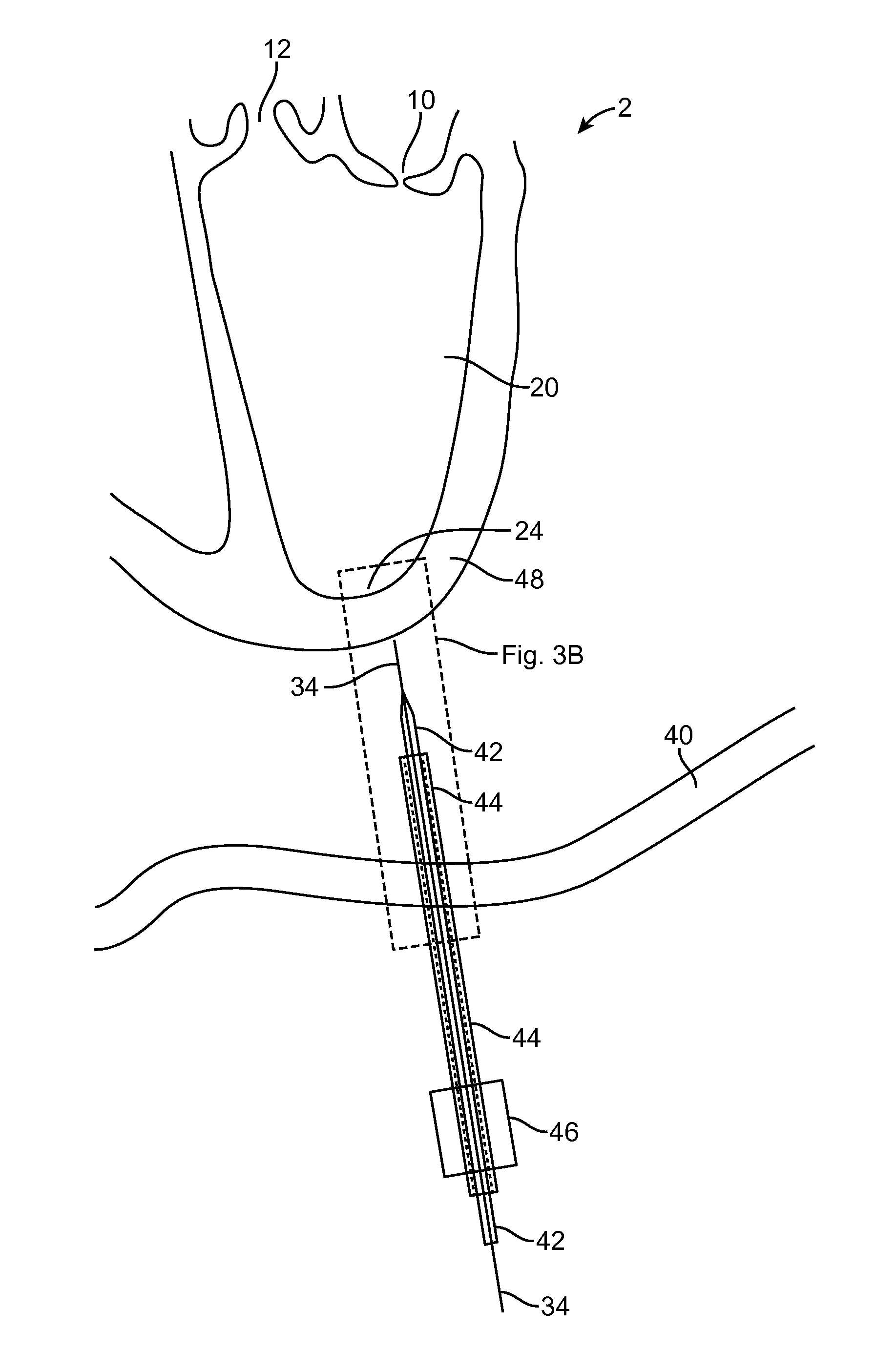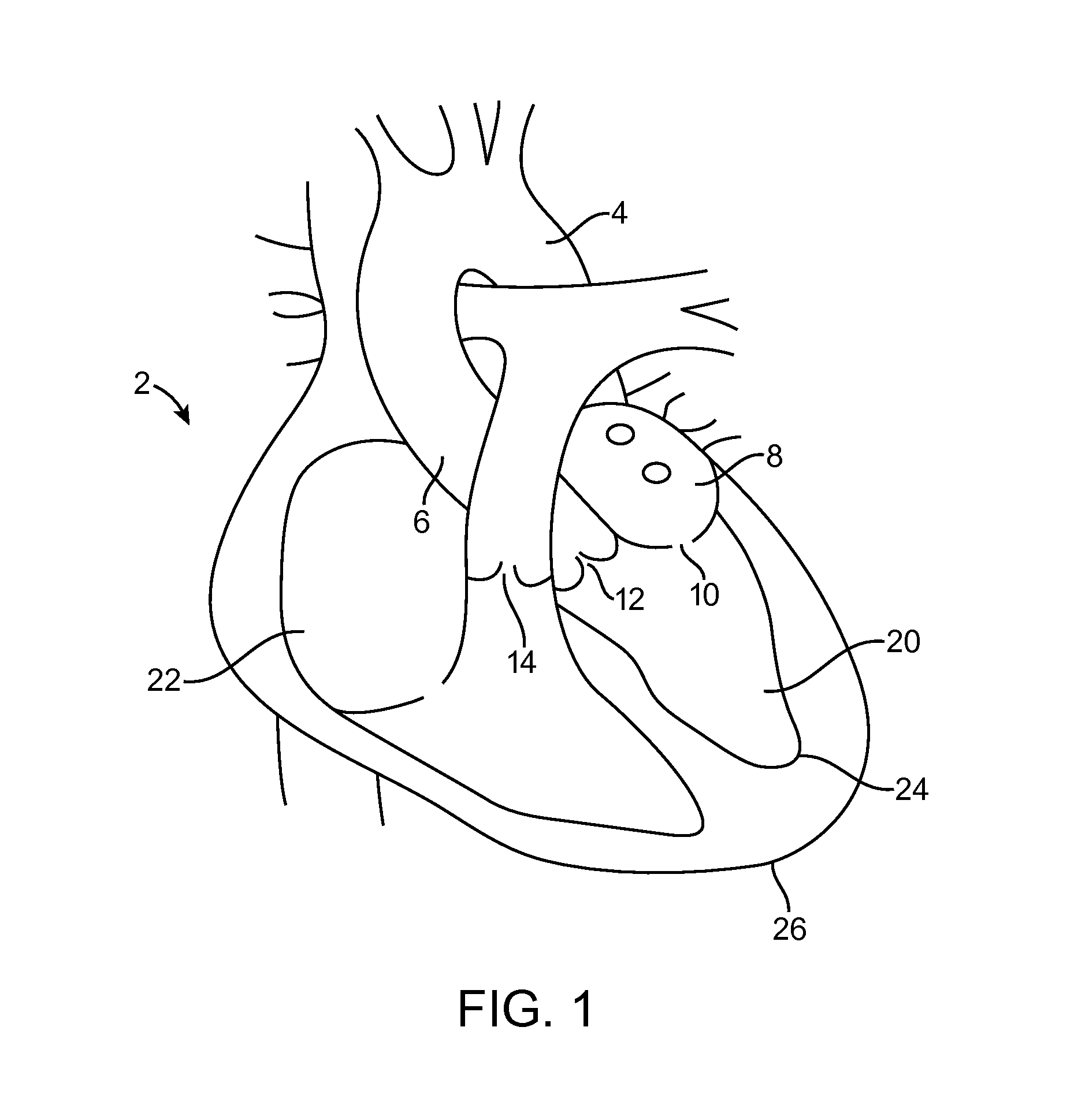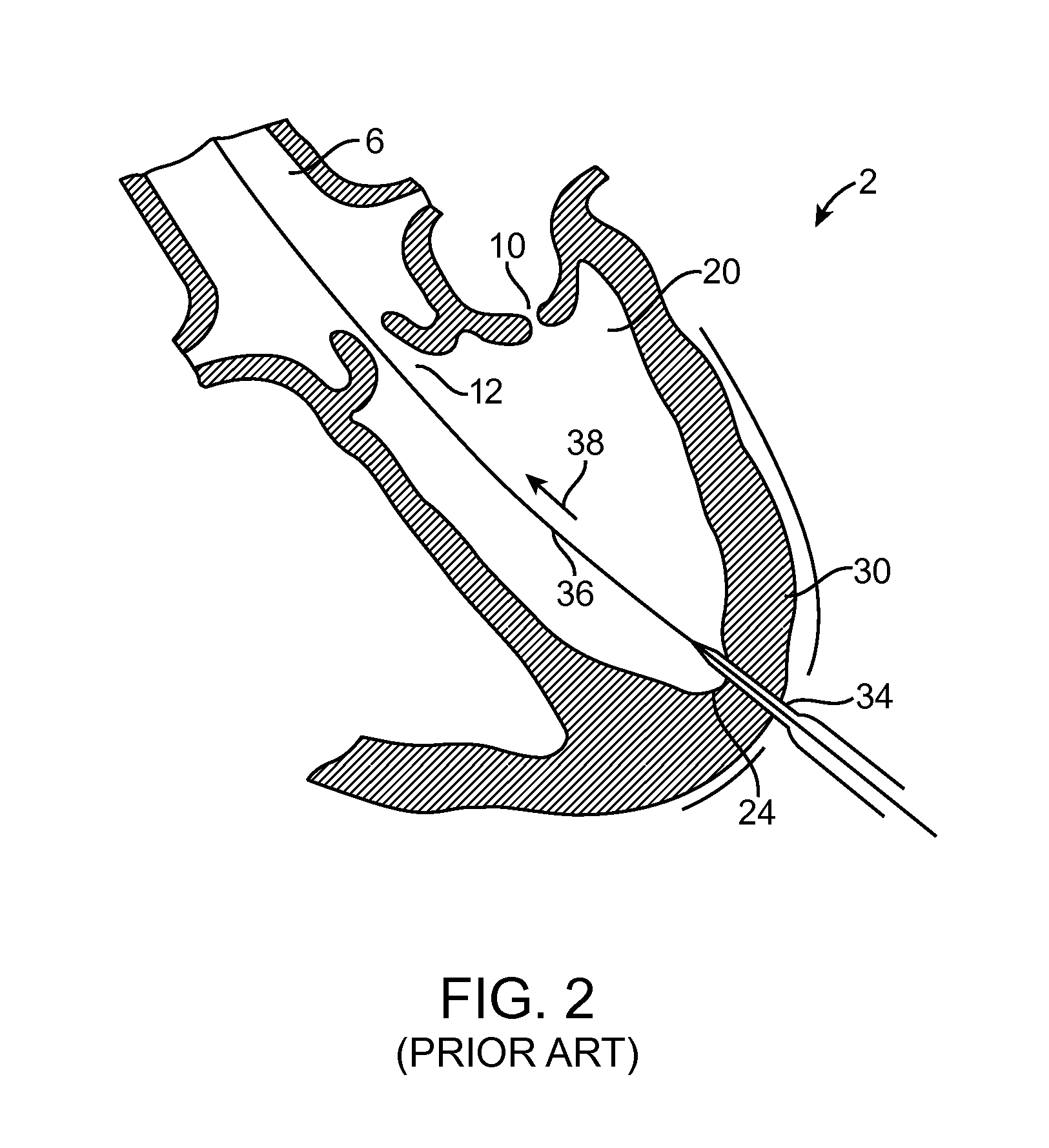[0004]One embodiment is directed to a method for providing
surgical access across a wall of a tissue structure, comprising: installing a guiding member into the wall of the tissue structure to a desired guiding depth; using the installed guiding member as a positional guide, advancing a helical member into the wall of the tissue to a desired helical member depth, the helical member comprising a helical member distal end removably coupled to an anchor member which is coupled to a distal end of a suture member, such that advancing the helical member into the wall causes the anchor member to be advanced into the wall and to pull a
distal portion of the suture member along with the anchor member into the wall to substantially encapsulate a number of helical loops of suture member that is greater than about 1 loop and less than about 3 loops; withdrawing the helical member from the wall of the tissue structure, leaving the anchor member in a deployed configuration decoupled from the helical member and coupled to at least a portion of the wall of the tissue structure; and tensioning the suture member to apply a load to the deployed anchor member. Installing a guiding member may comprise inserting an elongate instrument. The elongate instrument may be selected from the group consisting of: a guidewire, a needle, and a trocar. Installing the guiding member may comprise placing a distal end of the guiding member entirely across at least a portion of the wall of the tissue structure. Installing the guiding member may comprise placing a distal end of the guiding member only partially across a portion of the wall of the tissue structure. The helical member may be coupled to a guide interface element, and wherein using the installed guiding member as a positional guide may comprise movably
coupling the guide interface element to the guiding member. The method may further comprise using the guide interface element to determine when the helical member has been installed to the desired helical member depth. The guide interface element may define a lumen fluidly coupled to a a distal aperture, and wherein determining when the helical member has been installed to a desired depth comprises detecting the presence of blood at the distal aperture. Detecting the presence of blood at the distal aperture may comprise visually seeing the presence of blood within a space fluidly coupled to the lumen. The guide interface element may comprise a sensor, and determining when the helical member has been installed to the desired helical member depth may comprise receiving a
signal from the sensor. The sensor may be selected from a group consisting of: an
impedance sensor, a
partial pressure of
oxygen sensor, an OCT sensor, a
radiation transmission sensor, and a pressure
transducer. The desired helical member depth may be entirely across at least a portion of the wall of the tissue structure. The desired helical member depth may be a position incompletely across at least a portion of the wall of the tissue structure. Withdrawing the helical member and leaving the anchor member in the deployed configuration may leave the suture member in a suture helical configuration across the portion of the wall of the tissue structure. The suture helical configuration may be defined by a suture helical configuration
diameter selected to accommodate passage of one or more elongate instruments through the center of the suture helical configuration by expansion of the suture helical configuration within the wall of the tissue structure. The expansion of the suture helical configuration may be characterized by an expansion of an outer
diameter of the suture helical configuration that is between about 10 percent and about 35 percent. The method may further comprise passing one or more elongate instruments through the center of the suture helical configuration. The expansion of the suture helical configuration may be caused, at least in part, by the passing of the one or more elongate instruments through the center of the suture helical configuration. At least one of the one or more elongate instruments may comprise an introducer
catheter defining an instrument working channel therethrough. The introducer
catheter may comprise a geometrically tapered
distal portion. The method may further comprise passing one or more working instruments through the instrument working channel. At least one of the one or more working instruments may comprise an element selected from the group consisting of: a
prosthetic valve; a prosthetic clip; a grasper; a
dilator; an
endoscope; a
catheter; a
balloon; an
occlusion device; and an
ablation device. The method may further comprise retracting the one or more working instruments through the instrument working channel. The method may further comprise retracting the one or more elongate instruments through the center of the suture helical configuration. The method may further comprise tensioning the suture member to cause tissue captured by the suture helical configuration to close around the one or more elongate instruments. The method may further comprise tensioning the suture member to cause tissue captured by the suture helical configuration to close after the one or more elongate instruments have been completely been withdrawn. Tensioning the suture member to cause the suture helical configuration to close around the one or more elongate instruments may comprise simultaneously incrementally withdrawing the one or more elongate instruments while continuing to tension the suture member. Tensioning the suture member to cause the suture helical configuration to close around the one or more elongate instruments may comprise sequentially withdrawing the one or more elongate instruments, then tensioning the suture member. At least one of the one or more elongate instruments may comprise an element selected from the group consisting of: a
prosthetic valve; a valve introducer member; a prosthetic clip; a grasper; a
dilator; an
endoscope; a catheter; a
balloon; an
occlusion device; and an
ablation device. The method may further comprise retracting the one or more elongate instruments through the center of the suture helical configuration. The method may further comprise tensioning the suture member to cause tissue captured by the suture helical configuration to close around the one or more elongate instruments. The method may further comprise tensioning the suture member to cause tissue captured by the suture helical configuration to close after the one or more elongate instruments have been completely been withdrawn. Tensioning the suture member to cause the suture helical configuration to close around the one or more elongate instruments may comprise simultaneously incrementally withdrawing the one or more elongate instruments while continuing to tension the suture member. Tensioning the suture member to cause the suture helical configuration to close around the one or more elongate instruments may comprise sequentially withdrawing the one or more elongate instruments, then tensioning the suture member.
 Login to View More
Login to View More  Login to View More
Login to View More 


